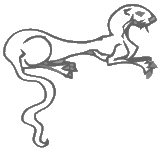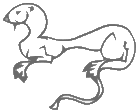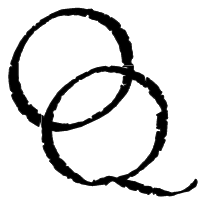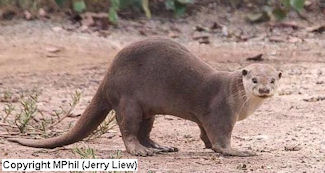 |
 |
 |
 |
 |
 |
 |
 |



Smooth Coated Otter
Size:
From nose to tail, this otter is 106 to 130 cm long. The
tail alone is 40 to 50 cm long.
Ecology Habitat: The smooth coated otter prefers to live in undisturbed areas. They live in mangrove forests, lowland lake and river systems, rice fields, or peat swamps. Sometimes they will hunt in seasonally flooded swamps. Smooth coated otters will travel long distances over land in search of a new habitat. Range/Distribution: Southeastern Asia, India, China, and Indonesia. There is a small population in the eastern Middle East.
Conservation
Status: Vulnerable
Smooth coated otters hunt both during the day and at night, sometimes alone and sometimes in large groups. When hunting in groups, they spread out across a body of water, drive their prey towards some obstacle like mudflats or rapids, and when the fish start to panic, they dive to catch them in their mouths. When hunting alone, they use their whiskers to detect movements in the water, and feel in the mud and crevices for food.
Behavior Life Cycle: The breeding season is between August and December, but is flexible. The smooth coated otter has a gestation period of 60 to 62 days, and give birth to between one and five pups. They open their eyes at about four weeks, and they start swimming at six. The pups are weaned at five months and leave home at about a year old. They reach sexual maturity at about two years of age. Smooth coated otters mate for life, and live in family groups consisting of the mating pair and their pups. Social: Smooth coated otters are highly social animals; often family groups will live and hunt together even after the pups are mature enough to establish their own territories. Mothers with new pups do not allow other otters into the holt, so the rest of the family sleeps either in other chambers of the burrow (which often has many entrances and 'rooms'), or outside in protected areas. The alpha female is dominant in these groups. There is little
conflict between group members, but occasionally mature females
will fight with the alpha female for dominance. More often,
young mature females will leave the group to form their own.
The alpha female determines hierarchy within the group, and
the alpha male moves the group through their territory. A family's
territory generally ranges between 4.3 and 7.5 sq. miles. Individual: Smooth coated otters are proficient both on land and in water. They are powerful swimmers, and on land they climb and jump quite well.
These otters are often trained by fishermen to drive fish into their nets.
Also called: Smooth Otter, India smooth
coated otter, Asian smooth coated otter Subspecies:
|
OtterQuest (c) 1999-current. Contact OtterQuest.
A few images on this web site have been borrowed from other sources, I credit them in the Links/Resource Page. Some may not yet be credited, if you know the source of an uncrdited photograph, please e-mail me with the information. Thank you. Dana


 Identification
Identification


